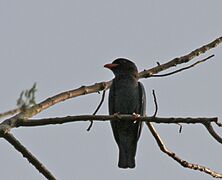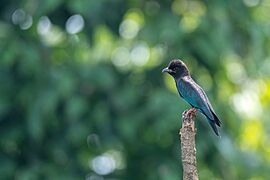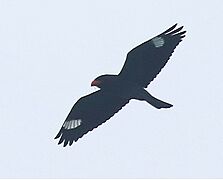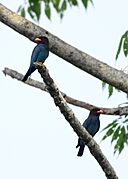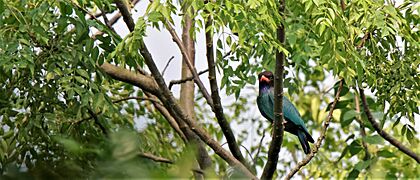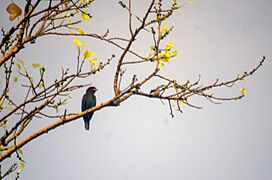Oriental dollarbird facts for kids
Quick facts for kids Oriental dollarbird |
|
|---|---|
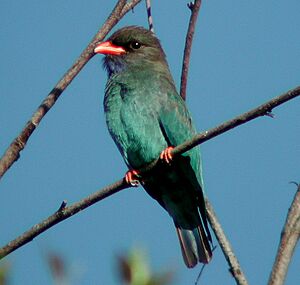 |
|
| Adult | |
| Conservation status | |
| Scientific classification | |
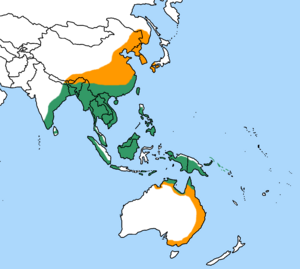 |
|
| Distribution of the oriental dollarbird | |
| Synonyms | |
|
Coracias orientalis Linnaeus, 1766 |
The Oriental dollarbird (Eurystomus orientalis) is a cool bird from the roller family. It gets its name from the special pale blue or white, coin-shaped spots on its wings, which look like "dollars"! You can find this bird in many places, from Australia all the way to Korea, Japan, and India.
Contents
About the Dollarbird's Name
The Oriental dollarbird was first officially described in 1766. A Swedish scientist named Carl Linnaeus gave it the scientific name Coracias orientalis. He wrote about it in his famous book, Systema Naturae.
Later, the dollarbird was placed in a different group, or genus, called Eurystomus. This name comes from ancient Greek words meaning "wide-mouthed." The second part of its scientific name, orientalis, is Latin for "eastern." This makes sense because the bird lives in eastern parts of the world.
People sometimes call this bird by other names too. These include the Asian dollarbird, dark roller, or eastern broad-billed roller.
Different Types of Dollarbirds
Scientists recognize ten different types, or subspecies, of the Oriental dollarbird. Each one lives in a slightly different area. Here are some of them:
- E. o. cyanocollis: Found from the Himalayas through China to Siberia, Korea, and Japan.
- E. o. orientalis: Lives from the southern Himalayas to Indochina, the Malay Peninsula, and islands like Sumatra and Java.
- E. o. laetior: Found in southwestern India.
- E. o. gigas: Lives on the southern Andaman Islands.
- E. o. irisi: Found in Sri Lanka.
- E. o. pacificus (also called the Australian roller): Lives on the Lesser Sunda Islands and in northern and eastern Australia.
- E. o. waigiouensis: Found in New Guinea and nearby islands.
- E. o. crassirostris: Lives in the Bismarck Archipelago.
- E. o. solomonensis: Found in the Solomon Islands.
What Does a Dollarbird Look Like?
The Oriental dollarbird can grow up to 30 centimeters (about 12 inches) long. Its body is mostly dark brown. But it has a beautiful bluish-green shine on its back and wings. Its belly is light colored.
The bird's throat and the feathers under its tail are a bright, shiny blue. Its flight feathers are also a darker blue. The dollarbird has a short, wide beak. In adult birds, the beak is orange-red with a black tip.
The most special feature is the light blue patches on the outer parts of its wings. These patches are very easy to see when the bird is flying. They look like coins, which is how the bird got its name!
Female dollarbirds look a little less bright than males. But overall, they are very similar. Young dollarbirds are much duller than adults. They don't have the bright blue on their throats. Their beaks and feet are brown instead of red.
Where Dollarbirds Live and Their Homes
The Oriental dollarbird lives in a wide area, from Australia to Japan and India. Birds from northern and eastern Australia breed there between September and April. During the cooler months, they fly to New Guinea and nearby islands.
These birds like to live in open wooded areas. They look for trees that have hollows. These hollows are perfect places for them to build their nests.
Dollarbird Behavior and Habits
You will most often see an Oriental dollarbird by itself. It likes to sit upright on a bare branch high in a tree. From this high spot, it watches for insects.
When it spots an insect flying by, it quickly flies out to catch it. This way of hunting is called "hawking." After catching its meal, the dollarbird usually flies right back to the same branch it was on before.
Gallery
-
at Jayanti in Buxa Tiger Reserve in Jalpaiguri district of West Bengal, India.
-
At Rangapur near Dhansar River, Nepal
-
Singing at Miami MetroZoo, USA
-
Oriental Dollar Bird at Central Park, Salt Lake, Kolkata



